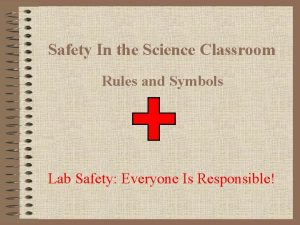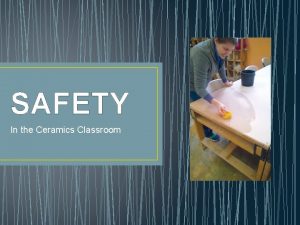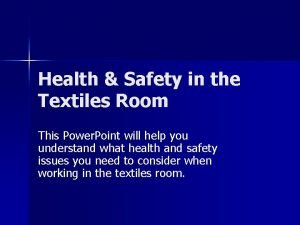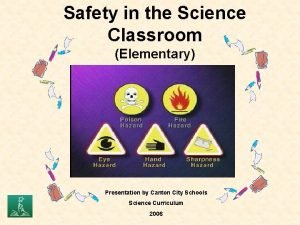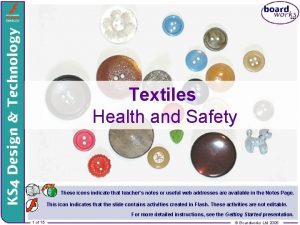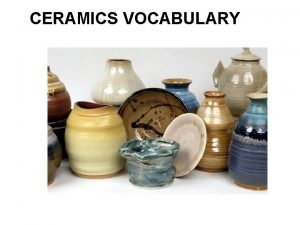SAFETY In the Ceramics Classroom Safety in Ceramics









- Slides: 9

SAFETY In the Ceramics Classroom

Safety in Ceramics • It is important to know that some of the materials used in this classroom can be hazardous. Basic safety and cleanup procedures minimize the potential issues in working with clay and glaze materials. • There are 3 ways that materials can enter the body. • Skin contact • Ingestion • Inhalation • We will discuss all of these and ways to maintain a safe studio.

Safety in Ceramics – Skin Contact • Materials may enter the body through cuts or burns • Irritation can be caused by a reaction to substances in clay or glaze. • Skin Allergies – If you know your skin is sensitive, take measures to protect it. • Prevention: • Cover hands with latex gloves if you will be glazing your work • If you have sensitive skin, please see

Safety in Ceramics – Ingestion • Materials can be ingested (swallowed) when your hands, contaminated with art chemicals, come in contact with your mouth. This happens most often when food or drinks are exposed to chemicals in the studio. • Prevention: • DO NOT EAT OR DRINK IN THE STUDIO! Especially when using glazes, slips, underglazes or stains. • Read the labels on all products. No students allowed in the glaze mixing area without permission of the instructor.

Safety in Ceramics – Inhalation • When clay dust becomes airborne, it can be inhaled by people in the studio. • Prevention: • Every effort should be made to control the amount of dust we produce in the studio. Silica dust in an inevitable product of working with clay. We must maintain a clean studio to prevent the dust from becoming airborne. Mopping (wet mop) and cleaning countertops is a priority. Clay left on the floor is ground up into dust and then can be kicked into the air. Pick up after yourself (and others!)

Safety in Ceramics – Muscle Strain • Clay, because of its moisture content, can be very heavy (especially a brand new 25 lb bag). • • Prevention: Seek help when lifting heavy objects or bags of clay. Bend at your knees when lifting. Lift with your legs. Avoid throwing for long periods of time – take breaks and stretch.

Safety in Ceramics – Heat and Electrical • Electricity and water do not belong together! • The kiln gets extremely hot (over 2000 degrees). • Prevention: • Clean up any water near electrical outlets. Get instructor if there any problems or if you need assistance. • Do not throw at the wheel with bare feet • Be aware that the OUTSIDE of the kiln gets hot as well and can burn you. Do not go near a firing kiln unless the instructor is near and you have permission. • Never place anything on top of or near the kiln – fires can be started this way. • Never attempt to start a kiln unless the instructor has given permission.

Safety in Ceramics – Other Concerns • Slipping – The studio floors can become very slippery when wet. Please be sure to immediately clean up any water that has spilled. Notify others of the wet floor. • First Aid and Emergencies • In the event that any safety issue requires treatment, please notify the instructor immediately. Do not walk out of class without informing the instructor. • In the event of an emergency, notify the instructor.

Clay Tools Metal rib/scraper Loop Tools (aka. ribbon tools for trimming) Sponge Wire Tool Needle tool Wooden Rib Wooden modeling tool

